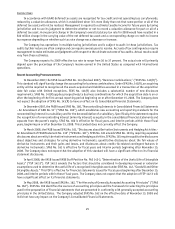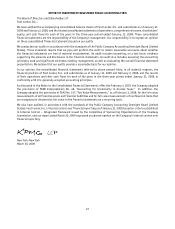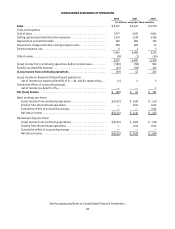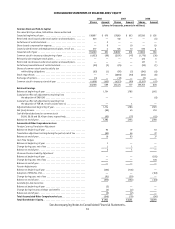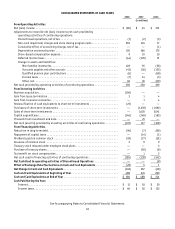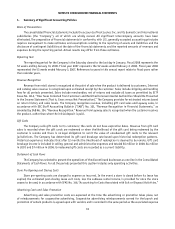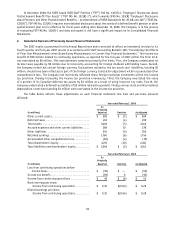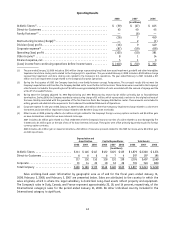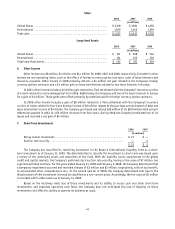Foot Locker 2008 Annual Report Download - page 51
Download and view the complete annual report
Please find page 51 of the 2008 Foot Locker annual report below. You can navigate through the pages in the report by either clicking on the pages listed below, or by using the keyword search tool below to find specific information within the annual report.35
Share-Based Compensation
Effective January 29, 2006, the Company adopted the provisions of Statement of Financial Accounting Standards
No. 123(R), “Share-Based Payment,” and related interpretations, (“SFAS No. 123(R)”) to account for stock-based
compensation. Among other things, SFAS No. 123(R) requires that compensation expense be recognized in the financial
statements for share-based awards based on the grant date fair value of those awards. Additionally, stock-based
compensation expense includes an estimate for pre-vesting forfeitures and is recognized over the requisite service
periods of the awards. During 2006, the Company recorded a cumulative effect of a change in accounting of $1 million
to reflect estimated forfeitures for prior periods related to the Company’s nonvested restricted stock awards. Prior
to the adoption of SFAS No. 123(R), the Company recognized compensation cost of restricted stock awards over the
vesting term based upon the fair value of the Company’s common stock at the date of grant. Forfeitures were recorded
as they occurred, however under SFAS No. 123(R), an estimate of forfeitures is required to be included over the vesting
term. Under SFAS No. 123(R), the Company will continue to recognize compensation expense over the vesting term, net
of estimated forfeitures. See note 25 for information on the assumptions the Company used to calculate the fair value
of stock-based compensation.
Upon exercise of stock options, issuance of restricted stock or issuance of shares under the employee stock
purchase plan, the Company will issue authorized but unissued common stock or use common stock held in treasury. The
Company may make repurchases of its common stock from time to time, subject to legal and contractual restrictions,
market conditions and other factors.
Cash and Cash Equivalents
The Company considers all highly liquid investments with original maturities of three months or less, including
commercial paper and money market funds, to be cash equivalents. Amounts due from third party credit card processors
for the settlement of debit and credit cards transactions are included as cash equivalents as they are generally collected
within three business days. Cash equivalents at January 31, 2009 and February 2, 2008 were $331 million and $472 million,
respectively.
Short-Term Investments
The Company accounts for its short-term investments in accordance with SFAS No. 115, “Accounting for Certain
Investments in Debt and Equity Securities.” At January 31, 2009, the Company’s short-term investment was $23 million,
which represents the fair value of its investment in the Reserve International Liquidity Fund, Ltd., a money market fund.
See note 4 for further discussion on this investment.
Merchandise Inventories and Cost of Sales
Merchandise inventories for the Company’s Athletic Stores are valued at the lower of cost or market using
the retail inventory method. Cost for retail stores is determined on the last-in, first-out (LIFO) basis for domestic
inventories and on the first-in, first-out (FIFO) basis for international inventories. The retail inventory method is
commonly used by retail companies to value inventories at cost and calculate gross margins due to its practicality.
Under the retail method, cost is determined by applying a cost-to-retail percentage across groupings of similar items,
known as departments. The cost-to-retail percentage is applied to ending inventory at its current owned retail valuation
to determine the cost of ending inventory on a department basis. The Company provides reserves based on current
selling prices when the inventory has not been marked down to market. Merchandise inventories of the Direct-to-
Customers business are valued at the lower of cost or market using weighted-average cost, which approximates FIFO.
Transportation, distribution center, and sourcing costs are capitalized in merchandise inventories. In accordance with
SFAS No. 151, “Inventory Costs- An Amendment of ARB 43, Chapter 4,” the Company expenses, in the period incurred, the
freight associated with transfers between its store locations. The Company maintains an accrual for shrinkage based
on historical rates.
Cost of sales is comprised of the cost of merchandise, occupancy, buyers’ compensation and shipping and handling
costs. The cost of merchandise is recorded net of amounts received from vendors for damaged product returns, markdown
allowances and volume rebates, as well as cooperative advertising reimbursements received in excess of specific,
incremental advertising expenses. Occupancy includes the amortization of amounts received from landlords for tenant
improvements.


